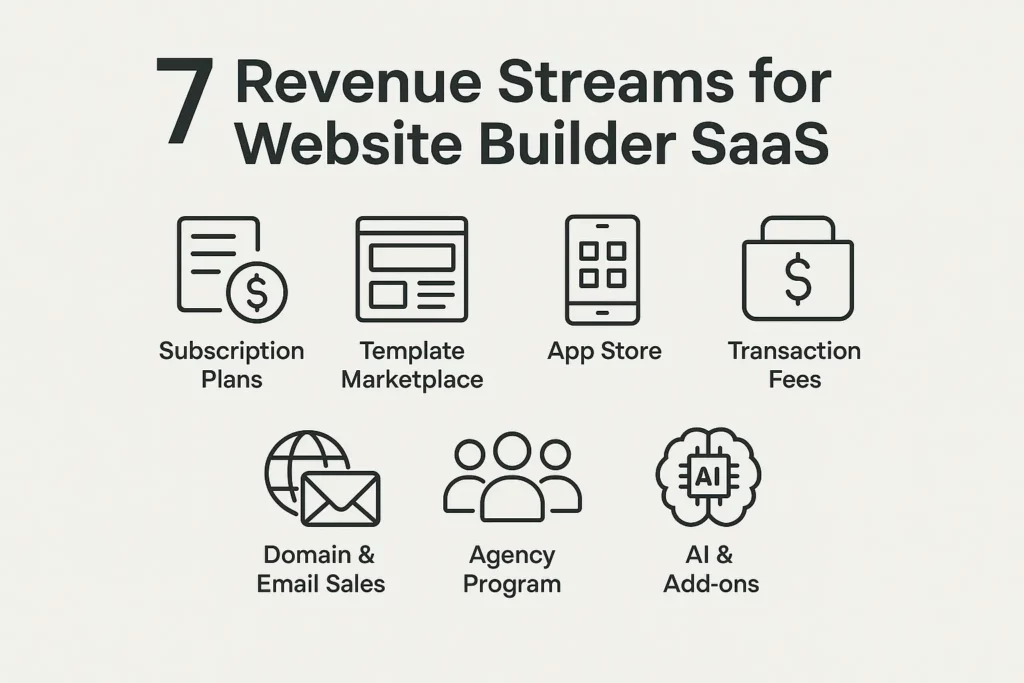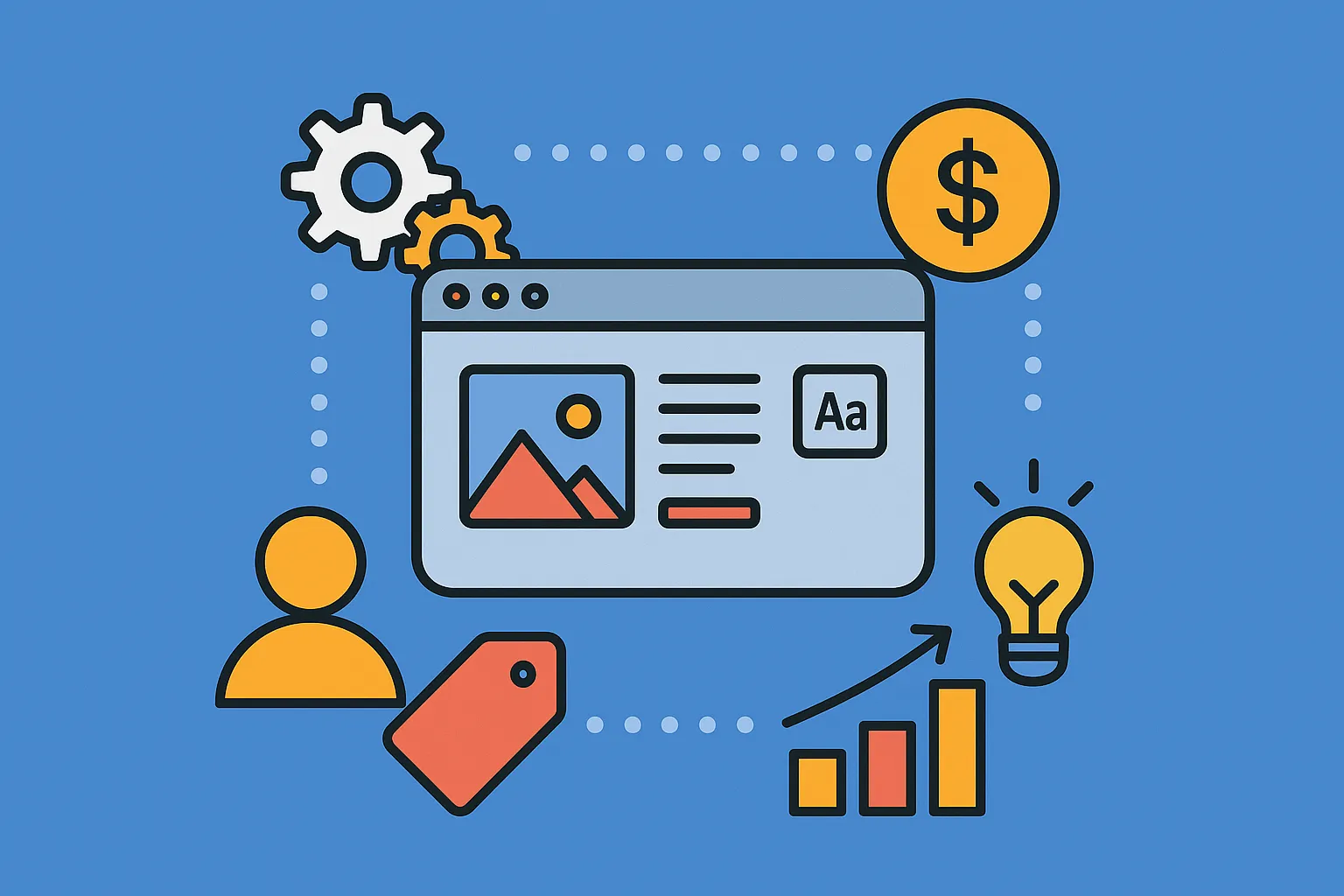Website builders aren’t just for DIY hobbyists anymore. In 2025, they’re essential for solo founders, bootstrapped startups, and even enterprise teams looking to move fast and build without code. The demand for SaaS-based website builders has skyrocketed because they solve two pressing problems: speed and scale. You don’t need to chase down a developer or wait three weeks for a landing page anymore—just drag, drop, and launch.
I remember helping a friend who launched her skincare brand during the lockdown. She started with Shopify, but outgrew it. She needed custom flows, multilingual pages, and better control—without drowning in dev costs. She shifted to a modular website builder SaaS, and that move alone doubled her conversion rate in three months.
If you’re building or running a website builder SaaS platform, the biggest question is this: how do you make real, scalable revenue from it? In this blog, I’ll break down the top revenue models that actually work in 2025—what users expect, how you price without scaring them off, and how to layer your offers for maximum growth.
Let’s dive into the nuts and bolts of SaaS monetization. Because a beautiful product is useless if it can’t pay your bills.
What Makes a Website Builder SaaS Different?
Before we dive into pricing models, here’s why website builder platforms stand out from traditional SaaS products:
- High retention: Once users build their site, they tend to stick around.
- Recurring infrastructure cost: Hosting, bandwidth, CDN, domains.
- Freemium-friendly: Users can try before they buy.
- Ecosystem potential: Add-ons, plugins, templates, integrations.
This combo creates room for multi-layered monetization—subscription, usage, transactions, and beyond.
Read more: How to Develop a Website Builder SaaS Platform App
7 Revenue Streams for Website Builder SaaS Platforms
Wondering how website builder SaaS companies actually make money? It’s not just about charging a monthly fee. From premium templates to plugin ecosystems and AI tools, these platforms stack multiple income streams to maximize value—and revenue. Let’s break down the 7 most effective monetization methods used in 2025

1. Subscription-Based Revenue (SaaS Core Model)
This is the bread-and-butter for 90% of website builders. You offer tiered monthly or annual plans, each with increasing levels of access:
| Plan | Typical Features | Price Range |
| Free | Basic templates, limited pages, ads | $0 |
| Starter | Custom domain, analytics | $5–$10/month |
| Pro | Advanced templates, SEO tools, support | $15–$25/month |
| Business | eCommerce, integrations, team roles | $30–$100/month |
Upsell tips:
- Offer a yearly discount to reduce churn.
- Let users start free and upgrade only when needed.
- Add smart feature nudges (“This feature is in Pro”).
2. Template & Theme Marketplace
Users love customization. Offer premium templates, UI kits, and theme bundles for one-time or subscription-based purchases. These can be made in-house or via third-party creators with a revenue share.
3. App Store / Plugin Ecosystem
Your platform becomes more valuable when users can install add-ons like live chat, pop-ups, forms, booking systems, or payments.
- Charge app developers platform fees.
- Offer in-house premium plugins on a pay-per-use or bundled basis.
4. Transaction Fees (Especially for eCommerce
If your builder supports online stores or booking features, take a small transaction fee (1–3%) on sales processed through your platform.
5. Custom Domain & Email Upsells
Domains and business emails are essential, so offer them directly via integrations (like Google Workspace or Namecheap).
You:
- Get a cut of domain/email sales
- Keep users locked into your ecosystem
Example: Wix makes a huge chunk of its revenue via domain & email upsells.
6. Agency or Reseller Program
Let agencies white-label your builder and resell it to clients. Charge a higher flat rate or a volume-based fee.
Offer:
- Admin dashboard for client sites
- Custom branding
- Priority support
This B2B2C strategy scales without bloating your support team.
7. AI Add-Ons & Smart Tools (Premium Features)
In 2025, AI isn’t just cool—it’s expected. Monetize smart features like:
- AI-generated website copy
- Smart image resizing
- SEO optimization
- Chatbot integrations
Bonus: Data Insights & Analytics
Offer advanced data visualizations and heatmaps as part of premium plans. Businesses crave metrics—turn that into a value-add upsell.
Challenges to Watch Out For
- Pricing fatigue: Too many microcharges can backfire.
- Churn: Seasonal or event-based users may drop off.
- Feature overload: Keep it simple—don’t overwhelm new users.
- Localization: Indian, MENA, and EU markets may need currency and tax adaptations.
How to Choose the Right Model (and Stack Them)
Don’t pick just one model. Stack 2–3 of them smartly:
| User Type | Ideal Stack |
| Casual Users | Free + domain/email upsell |
| Small Biz Owners | Pro Subscription + AI add-ons |
| Agencies | White-label plan + app store access |
| eCommerce Creators | Business Plan + transaction fee model |
Explore our powerful website builder solution to launch your own SaaS platform with ease and flexibility.
Conclusion
Monetizing a website builder SaaS isn’t just about placing paywalls—it’s about creating smart, strategic opportunities for users to see value and willingly invest. By deeply understanding your audience, offering flexible pricing models, and continuously adding features that solve real problems, you can build an ecosystem that users find indispensable. The key is to create a platform where users feel empowered, not pressured—ensuring long-term loyalty and sustainable revenue growth.
At Miracuves, we help innovators launch high-performance app clones that are fast, scalable, and monetization-ready. Ready to turn your idea into reality? Let’s build together.
FAQs
Q1: What’s the most common revenue model for website builders?
Subscription tiers (Free, Pro, Business) remain the gold standard, often combined with add-on sales.
Q2: Can I make money with a free plan?
Yes! Upsell premium templates, plugins, domains, and collect transaction fees.
Q3: What’s a good monthly price for a Pro plan?
$15–$30 is the sweet spot for small businesses, depending on features.
Q4: How do website builders monetize eCommerce sites?
By charging transaction fees, selling premium store templates, and offering integrations like payment gateways.
Q5: Is it necessary to build an app store?
Not necessary, but it’s a huge growth lever. Apps make your platform sticky and create a new revenue stream.
Q6: What about enterprise users?
Offer custom plans with SLAs, account management, and usage-based pricing.
Realted Articles:








